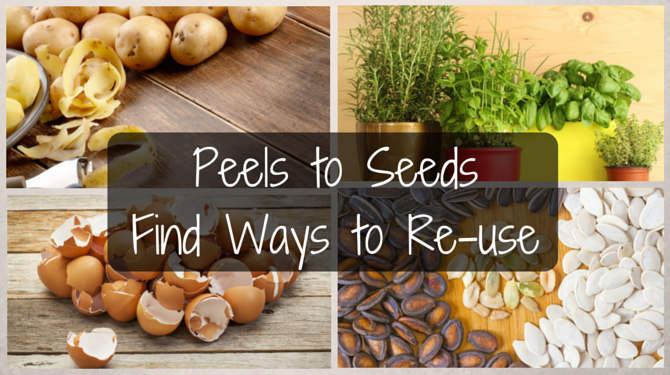
11 Tips to Make most of Raw & Cooked Foods

It is a common sight (and neither an appealing one) to see so much food waste (not on streets) but in your own garbage bin. Food scraps make most of the household garbage and contribute to tons of waste generated and left to rot around in dump yards and landfills. Here we give 11 simple tips to use those bits and ends making most of raw and cooked foods.
- Leftover cooked food- Quite often you land up with “a small katori” of vegetable from dinner. Do not let it rot in fridge, only to find its way to the dustbin. Instead use them the very next day by using it as sandwich or wrap filler or adding to lightly cooked rice. There are plenty of recipes which can be found on reusing of all kinds of cooked food leftovers.
- Save the eggshells- Don’t toss away those calcium rich eggshells into the bin. Instead, grind them and sprinkle it over plant soil. Not only does it nourish the plants but also maintains soil alkalinity. Similarly, the ground, used beans of filter coffee also make a great supplement for plants. These coffee grounds can be used for exfoliating, combatting cellulite, improving the shine as well as colour of your hair, and making a cleansing mask. Also, placing coffee grounds in your refrigerator or freezer will help neutralize any odours.
- Perfect peels- As we are exploring recipes beyond the Indian terrain, you would have come across certain of them calling for lemon zest or zest of any citrus fruit. So next time you dig into an orange or sweet lime or squeeze lime juice for a citrusy touch to your dish, save the peels, dry them, grind them and sprinkle them whenever required, make sure the peels are washed well before use. For ginger save the peels and steep them in water to make tea, or drown them in olive oil, which you can use to make ginger-tinged salad dressings. Citrus peels can also be used as cleanser for both house and yourself.
- Trimmed off bread edges- A common scenario with children and you are left with a bunch of bread edges. Roast them or bake them (make sure they are dry) and coarsely grind them to make bread crumbs or lightly fry and make croutons. Store in airtight container and you have some funky ingredients on hand. In case you have stale bread slices still hibernating in your fridge but not gone bad (no fungus or weird smell in it), make a delicious bread pudding of it.
- Cauliflower and beet tops- Almost always landing in the bin. You can save these, steam them with a little butter and your favourite spices and add them to salads or pastas.
- Hold onto the stems- After plucking the leaves off (like coriander, mint, methi), the stems are dumped into the bin. But these are nutritious as well and justice should be done to them. Next time you clean a bunch of coriander, use stems to infuse oils used for exotic preparations, blend the stems to puree and add to dishes as pesto, add them to veggie or meat stocks for flavour.
- Stock up the seeds- Seeds from muskmelon, pumpkin, watermelon, avocado are actually edible! Wash them well, sun dry them or bake them, roast a little and lightly salt them for taste. Now you have homemade mix seed trail which can be had as it is, sprinkle over salads or powdered and added to smoothies or make snack bars. Have it your way. Watermelon seeds are best had after sprouting.
- Savour the skins- In case you are stocking organic produce, save the peels (potato), bake them with little oil and you have a potato-skin chip ready for snacking. If you are buying non-organic produce, then first soak the peels in salt water to remove some pesticide and then bake and enjoy. Ever thought about banana peel? You can make chutney or sandwich spreads from them.
- Gone over ripe- Tomatoes generally get hoarded and then start to soften, making them unusable for salads. So treat these over ripe tomatoes right and make them into a homemade sauce you can use to add to curries, pasta and gravies. Similarly, for fruits like chickoo, bananas which ripe real fast, remove peels, cut them and freeze. Once frozen, blend with a little cream and chocolate, fruit ice-cream ready!
- Regrow, reuse and repeat- Certain foods like curry leaves, chilly, lemongrass, bean sprouts, ginger, mint can be regrown in small spaces in potted plants. They are generally required in small quantities, so you will have a small home stock to rely on for pesticide free, healthy foods.
- Milk gone bad? Don’t mindlessly drain sour milk into the sink. Instead, boil it and separate the whey and solids. You can use the whey by adding to the chapatti dough or baked goodies and the solids to make famous Bengali sweets like rosogulla or sandesh.
Two important tips to bear in mind are:
- Shop in your refrigerator first! Cook or eat what you already have at home before buying more.
- If you see produce reaching the end of its life and know you won’t be using it in time, freezing or drying is the perfect way to keep it from going to the waste bin.
With these tips, you are bound to decrease a little of your expenditure and increase a lot of nutrition in your meal. By using every part of a food, not only are you saving the planet but also contributing to betterment of future generations and exploring ways to truly enjoy an entire food. Remember nutrients are for your body, not the garbage bin. The mantra reduce, reuse and recycle is the way to go. Keep the good works going!










